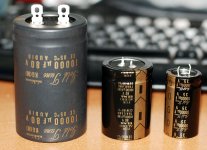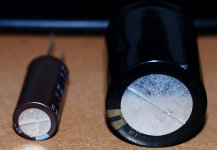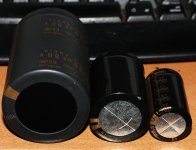Hi Luke
You didnt give me your address
so how can i ...
Because you might have my address from my last parcel of goodies
I've done some experiments on measuring actual capacitance. I can reliably measure 1000uF caps using a 220uH coil in parallel. Get a nice impedance peak that can show pretty closely the value of the cap.
However when I move to 10,000 uF the resonant peak's impedance drops by a factor of 10 and it is too low for me to pick it up. I'm not sure if I can wind a low enough esr coil to do the measurement. Ironically the 330uH ones I made for my crossover may be ok but I'm not about to desolder those, and I'm not sure I want to wind another one.
Using the passive component measurement in speaker workshop is no good. 1000uF measures as about 550uF and 10,000uF measures as 1200uF
You might want to hold off sending pocoyo until I can say yay or nay as to whether I can get a decent measurement.
Tony.
However when I move to 10,000 uF the resonant peak's impedance drops by a factor of 10 and it is too low for me to pick it up. I'm not sure if I can wind a low enough esr coil to do the measurement. Ironically the 330uH ones I made for my crossover may be ok but I'm not about to desolder those, and I'm not sure I want to wind another one.
Using the passive component measurement in speaker workshop is no good. 1000uF measures as about 550uF and 10,000uF measures as 1200uF
You might want to hold off sending pocoyo until I can say yay or nay as to whether I can get a decent measurement.
Tony.
OK I've just done an RC time constant test on a 1,000uF elna silmic II and on a 10,000uF Nichicon KG 35V cap.
The circuit consists of a 0.1% 10K resistor switched so that it iether shorts the cap to ground via the 10K resistor or connects it to +10V (regulated supply). with voltmeter across the cap.
The switch is thrown and stopwatch started. Stopwatch is stopped when the meter reads 6.3V.
The 10K resistor is a bit low for the 1000uF cap but I used it for the initial test. time taken was 11.5 seconds which equates to 1150 uF (or about 10% over) spec there may be some delay in the on/off of the stopwatch so the results for the 10,000uF are more accurate because it takes a lot longer to get there.
The time for the 10,000 uF cap was 104 seconds, which equates to 10,400 uF.
So I think I can safely measure the capacitance. I can also potentially do some other tests (other than the ESR test with my meter) if I read up on them.
Tony.
The circuit consists of a 0.1% 10K resistor switched so that it iether shorts the cap to ground via the 10K resistor or connects it to +10V (regulated supply). with voltmeter across the cap.
The switch is thrown and stopwatch started. Stopwatch is stopped when the meter reads 6.3V.
The 10K resistor is a bit low for the 1000uF cap but I used it for the initial test. time taken was 11.5 seconds which equates to 1150 uF (or about 10% over) spec there may be some delay in the on/off of the stopwatch so the results for the 10,000uF are more accurate because it takes a lot longer to get there.
The time for the 10,000 uF cap was 104 seconds, which equates to 10,400 uF.
So I think I can safely measure the capacitance. I can also potentially do some other tests (other than the ESR test with my meter) if I read up on them.
Tony.
Hi Pocoyo, the cap arrived today  The only test I have done as yet is the esr test and it was the same as the two other Nichicon 10,000uF caps I have. basically a zero reading. Tonight though both the 35V nichicon and the Cap you have sent me, fluctuated between a reading of 0.00 and 0.01. so the esr may be somewhere between 0.005 and 0.01. If I get a chance I may take my meter into a local electronics store and try measuring the esr of a generic brand 10,000 uF cap for comparison
The only test I have done as yet is the esr test and it was the same as the two other Nichicon 10,000uF caps I have. basically a zero reading. Tonight though both the 35V nichicon and the Cap you have sent me, fluctuated between a reading of 0.00 and 0.01. so the esr may be somewhere between 0.005 and 0.01. If I get a chance I may take my meter into a local electronics store and try measuring the esr of a generic brand 10,000 uF cap for comparison 
The other "test" that I did was to measure the weight of the cap. it is 68g The 35V nichicon KG weighs 26g The 80V nichicon KG weighs more than 100g (my scale only goes to 100g).
Pictures attached.
1st The Elna for audio cap is in the middle between the 80V nichicon KG and the 35V nichicon KG, as you can see there is a big difference in the size, but the 80V nichicon is a big cap!
2nd pic is a comparison of the ends of an elna silmic II and the cap under test. You can see two small dents in the cap, I assume these occurred during shipping. The creases in the end cap do not look 100% even on the cap under test, the grooves look like they have been scored rather than punched maybe. I'm not sure if that is significant or not.
Anyway It is getting a bit late so I think I will leave the capacitance test until tomorrow.
Tony.
The other "test" that I did was to measure the weight of the cap. it is 68g The 35V nichicon KG weighs 26g The 80V nichicon KG weighs more than 100g (my scale only goes to 100g).
Pictures attached.
1st The Elna for audio cap is in the middle between the 80V nichicon KG and the 35V nichicon KG, as you can see there is a big difference in the size, but the 80V nichicon is a big cap!
2nd pic is a comparison of the ends of an elna silmic II and the cap under test. You can see two small dents in the cap, I assume these occurred during shipping. The creases in the end cap do not look 100% even on the cap under test, the grooves look like they have been scored rather than punched maybe. I'm not sure if that is significant or not.
Anyway It is getting a bit late so I think I will leave the capacitance test until tomorrow.
Tony.
Attachments
OK I've just done the capacitance test. Charge time was 97 seconds, which equates to a capacitance of 9700uF, which is well within typical +- 20% for electrolytics. in fact that is -3% which is very good.
So despite its relatively small physical size this cap is definitely a 10,000uF cap. So there is nothing wrong with that spec.
The dimensions of the cap are 35mm diameter and 50mm high (body height not counting the leads). This cornel Dublier datasheet has 10,000uF 80V caps with dimensions of 35 D X 45 mm H so there is nothing magical about it's dimensions (ie a cap of this physical size can have this capacitance and voltage rating).
I'm not too keen to try and rig up a high voltage supply to test it in smoothing duties at close to it's rated voltage. I only have a dual winding 45V AC transformer which would give around 63V rectified.
So my conclusion at this stage is.
The cap certainly meets the capacitance specification. It is low ESR, so it should be good for power supply duty.
I can't say one way or another whether it meets its voltage specification, but it is certainly physically possible that it will.
The end cap has a vent which looks like an Elna vent. This sample looks a little less than perfect but that could be a manufacturing glitch.
I can't say for certain it is, or it isn't a genuine Elna Cap. But it does appear to be good quality.
If anyone would like to suggest any other tests that I could do please speak up I'm a bit time pressed at the moment but I will see what I can do.
I'm a bit time pressed at the moment but I will see what I can do.
Tony.
So despite its relatively small physical size this cap is definitely a 10,000uF cap. So there is nothing wrong with that spec.
The dimensions of the cap are 35mm diameter and 50mm high (body height not counting the leads). This cornel Dublier datasheet has 10,000uF 80V caps with dimensions of 35 D X 45 mm H so there is nothing magical about it's dimensions (ie a cap of this physical size can have this capacitance and voltage rating).
I'm not too keen to try and rig up a high voltage supply to test it in smoothing duties at close to it's rated voltage. I only have a dual winding 45V AC transformer which would give around 63V rectified.
So my conclusion at this stage is.
The cap certainly meets the capacitance specification. It is low ESR, so it should be good for power supply duty.
I can't say one way or another whether it meets its voltage specification, but it is certainly physically possible that it will.
The end cap has a vent which looks like an Elna vent. This sample looks a little less than perfect but that could be a manufacturing glitch.
I can't say for certain it is, or it isn't a genuine Elna Cap. But it does appear to be good quality.
If anyone would like to suggest any other tests that I could do please speak up
Tony.
did you check the discharge time?
Leakage current will corrupt your results.
By doing both a charge and a discharge comparison you can estimate the leakage current and thereby determine the actual "charging" current. From there you can check the capacitance.
That's the way a 555 timer set to deliver sawtooth to a cap is used to determine an approximate capacitance.
I don't know how a DMM does it.
Leakage current will corrupt your results.
By doing both a charge and a discharge comparison you can estimate the leakage current and thereby determine the actual "charging" current. From there you can check the capacitance.
That's the way a 555 timer set to deliver sawtooth to a cap is used to determine an approximate capacitance.
I don't know how a DMM does it.
ok thanks Andrew. I'll have to read up on reforming caps, but I suspect I don't have a high enough voltage source to do it properly.
So I charge the cap to full capacity and time discharge down to 37% capacity, which should be close to the time to charge up to 63% capacity from empty.
Thanks,
Tony.
So I charge the cap to full capacity and time discharge down to 37% capacity, which should be close to the time to charge up to 63% capacity from empty.
Thanks,
Tony.
ok thanks Andrew. I'll have to read up on reforming caps, but I suspect I don't have a high enough voltage source to do it properly.
So I charge the cap to full capacity and time discharge down to 37% capacity, which should be close to the time to charge up to 63% capacity from empty.
Thanks,
Tony.
I'm going to use one of these to reform the 12000/63 caps from Pocoyo's other listing. Note the 105VAC max source, might be a problem for you. I have a 90VAC source so it is not for me.
eBay - New & used electronics, cars, apparel, collectibles, sporting goods & more at low prices
If the date on the 10000/80 is correct at 2011, then there is no need to reform these caps.
^i use high resistances >10kohms in series with the cap to be reformed
my voltage source is about 75volts dc unloaded, in one set of japanese computer grade caps i reformed, the rating on the label says 56000ufd/63 volts, voltage was up to 75 with very very negligible current.....
my voltage source is about 75volts dc unloaded, in one set of japanese computer grade caps i reformed, the rating on the label says 56000ufd/63 volts, voltage was up to 75 with very very negligible current.....
I was going to mount 4 caps on the $1 power supply pcb Pocoyo was selling with the 12000/63 caps and place 22K/2W resistors in place of each of the rectifiers. That setup should get me reforming caps 4 at a time. Also, an in-line ammeter to measure leakage current once I get up to voltage, but I'm not quite sure that part will work. The higher leakage current from the 4 caps should help the accuracy of results if it does. I will post photos of my setup and results on the 12000/63 thread. So far, those caps have measured spot on as to capacitance and quite low in esr. A super bargain.
Last edited:
- Status
- This old topic is closed. If you want to reopen this topic, contact a moderator using the "Report Post" button.



